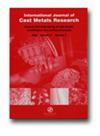电渣重熔熔覆球墨铸铁的固相转变
IF 1.1
4区 材料科学
Q3 METALLURGY & METALLURGICAL ENGINEERING
International Journal of Cast Metals Research
Pub Date : 2021-06-26
DOI:10.1080/13640461.2021.1945221
引用次数: 0
摘要
采用电渣重熔熔覆(ESRC)技术制备了以高速钢(HSS)包覆层和球墨铸铁(DCI)辊芯为包覆层的双金属复合轧辊,比较了ESRC工艺前后DCI辊芯石墨形貌、基体组织和力学性能的变化。在ESRC过程中,DCI芯先加热到高温,然后冷却到室温,导致石墨形貌恶化,球化率低,尺寸大,分布不均匀,并且导致基体结构从片层珠光体+少量碳化物向贝氏体+大量碳化物转变。基于石墨球度、基体结构、碳化物含量的变化,ESRC工艺前后DCI的抗拉强度和冲击韧性分别从458 MPa、3.02 J/cm2变化到417 MPa、5.74 J/cm2。本文章由计算机程序翻译,如有差异,请以英文原文为准。
Solid-state phase transformation of ductile cast iron during electroslag remelting cladding
ABSTRACT A bimetallic composite roll with the cladding layer of high-speed steel (HSS) and the roll core of ductile cast iron (DCI) was manufactured by the electroslag remelting cladding (ESRC) technology, and the changes in the graphite morphology, matrix structure, and mechanical properties of the DCI core before and after the ESRC process were compared. The DCI core was first heated to a very high temperature and then cooled down to room temperature during ESRC which led to a deteriorative graphite morphology with a low spheroidisation rate, a large size, and a nonuniform distribution and also caused a solid-state phase transformation of the matrix structure from lamellar pearlite + few carbides to bainite + large amounts of carbides. Based on the changes of graphite sphericity, matrix structure, carbides content, the tensile strength and impact toughness of DCI before and after the ESRC process changed from 458 MPa, 3.02 J/cm2 to 417 MPa, 5.74 J/cm2, respectively.
求助全文
通过发布文献求助,成功后即可免费获取论文全文。
去求助
来源期刊
CiteScore
2.70
自引率
7.10%
发文量
14
审稿时长
7.5 months
期刊介绍:
The International Journal of Cast Metals Research is devoted to the dissemination of peer reviewed information on the science and engineering of cast metals, solidification and casting processes. Assured production of high integrity castings requires an integrated approach that optimises casting, mould and gating design; mould materials and binders; alloy composition and microstructure; metal melting, modification and handling; dimensional control; and finishing and post-treatment of the casting. The Journal reports advances in both the fundamental science and materials and production engineering contributing to the successful manufacture of fit for purpose castings.

 求助内容:
求助内容: 应助结果提醒方式:
应助结果提醒方式:


